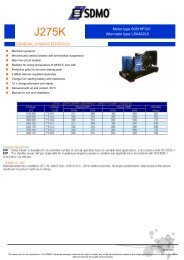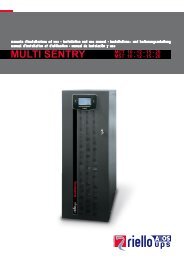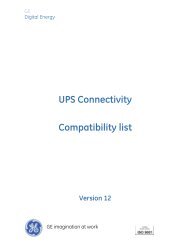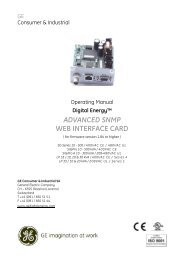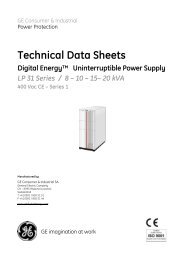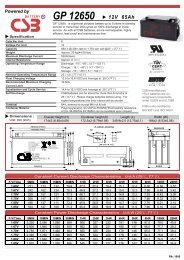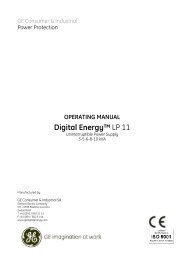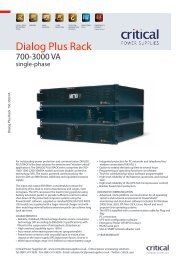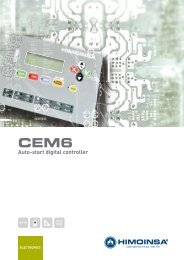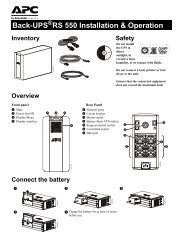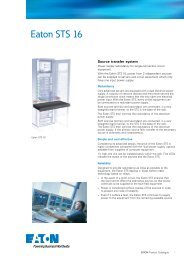UPS Handbook - Critical Power Supplies
UPS Handbook - Critical Power Supplies
UPS Handbook - Critical Power Supplies
Create successful ePaper yourself
Turn your PDF publications into a flip-book with our unique Google optimized e-Paper software.
Double Conversion<br />
A <strong>UPS</strong> design in which the primary power path consists of a<br />
rectifier and inverter. Double-conversion isolates the output<br />
power from all input anomalies such as low voltage surges<br />
and frequency variations.<br />
Downtime<br />
The time during which a functional unit cannot be used<br />
because of a fault within the functional unit or within the<br />
environment.<br />
Dry Contact<br />
Dry contact refers to a contact of a relay which does not<br />
make or break a current.<br />
Efficiency<br />
The ratio of output power to input power. It is generally<br />
measured at full-load and nominal line conditions. If power<br />
efficiency of a device is 90per cent, you get back ninety watts<br />
for every hundred you put in. The rest is mainly dissipated as<br />
heat from the filtration process.<br />
Electrical Line Noise<br />
Radio frequency interference (RFI), electromagnetic<br />
interference (EMI) and other voltage or frequency<br />
disturbances.<br />
Electromagnetic Interference (EMI)<br />
Electrical interference that can cause equipment to work<br />
improperly. EMI can be separated into conducted EMI<br />
(interference conducted through cables out of the <strong>UPS</strong>) and<br />
radiated EMI (interference conducted through the air).<br />
ePDU<br />
A power distribution unit that mounts to rack enclosures and<br />
distributes power to connected devices via a wide variety of<br />
output receptacles.<br />
Flooded Battery<br />
A form of battery where the plates are completely immersed<br />
in a liquid electrolyte.<br />
Frequency<br />
The number of complete cycles of AC voltage which occurs<br />
during one second (Hz). In EMEA region, electrical current is<br />
supplied mainly at 50 Hz, or 50 cycles per second.<br />
Ground<br />
A conducting connection, whether intentional or accidental,<br />
by which an electric circuit or equipment is connected to the<br />
earth, or to some conducting body of relatively large extent<br />
that serves in place of the earth.<br />
Earth ground symbol<br />
Harmonics<br />
A sinusoidal component of an AC voltage that a multiple of<br />
the fundamental waveform frequency. Certain harmonic<br />
patterns may cause equipment problems.<br />
Harmonic Distortion<br />
Regularly appearing distortion of the sine wave whose<br />
frequency is a multiple of the fundamental frequency.<br />
Converts the normal sine wave into a complex waveform.<br />
Hertz (Hz)<br />
A unit of frequency equal to one cycle per second.<br />
High Efficiency Mode<br />
A mode of <strong>UPS</strong> operation that cuts energy usage and<br />
operating costs.<br />
High Voltage Spike<br />
Rapid voltage peak up to 6,000 volts.<br />
Hot Swappable<br />
The ability to change a module without taking the critical load<br />
off the <strong>UPS</strong>. See also User Replaceable.<br />
The batteries on this Eaton 9130 <strong>UPS</strong> are hot swappable.<br />
IGBT<br />
Insulated gate bipolar transistor or IGBT is a three-terminal<br />
power semiconductor device, noted for high efficiency and<br />
fast switching. It switches electrical power in many modern<br />
applications such as electric cars, trains and <strong>UPS</strong>s.<br />
Impedance<br />
The total opposition to alternating current flow in an electrical<br />
circuit.<br />
Input Voltage Range<br />
The voltage range within which a <strong>UPS</strong> operates in “normal”<br />
mode and without requiring battery power.<br />
Inrush Current<br />
The maximum, instantaneous input current drawn by an<br />
electrical device when first turned on. Some electrical devices<br />
draw several times their normal full-load current when first<br />
energised.<br />
Inverter<br />
<strong>UPS</strong> assembly that converts internal DC power to output AC<br />
power to run the user’s equipment. When the inverter is<br />
supporting 100per cent of the load at all times, as with an<br />
online <strong>UPS</strong>, there is no break from utility power to battery<br />
power.<br />
Kilovolt Ampere (kVA)<br />
One thousand volt-amperes. Common measurement of<br />
equipment capacity. An approximation of available power in an<br />
AC system that does not take the power factor into account.<br />
Kinetic Energy<br />
The energy an object possesses because of its motion.<br />
Linear Load<br />
AC electrical loads where the voltage and current waveforms<br />
are sinusoidal. The current at any time is proportional to the<br />
voltage.<br />
Line Conditioner<br />
A device intended to improve the quality of the power that is<br />
delivered to electrical load equipment. A line conditioner is<br />
generally designed to improve power quality (e.g. proper<br />
voltage level, noise suppression, transient impulse protection,<br />
etc.).<br />
Line Interactive<br />
An offline <strong>UPS</strong> topology in which the system interacts with<br />
the utility line in order to regulate the power to the load.<br />
Provides better protection than a standby system but is not as<br />
fully prepared against irregularities as a full double-conversion<br />
system.<br />
Load<br />
The equipment connected to and protected by a <strong>UPS</strong>.<br />
32 eaton corporation <strong>UPS</strong> <strong>Handbook</strong>, EMEA version



